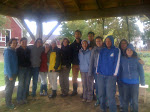 |
| Monster truck |
Wednesday, my name came up for the lunch rotation with Caitln's and she designed and executed an amazing taco lunch. My first jot was to harvest the chard, so I jumped into my favorite farm truck (affectionately known as the Monster Truck--though I'm not sure if it is called Monster because it is large or because it looks like it was attacked by Godzilla...) and drove out to North Wyslawski field for some beautiful Swiss chard.
 |
| Almost all the colors of the rainbow! |
 |
| New salad spinner |
This beautiful chard all comes from the same seed--each plant expresses some different gene, I'm guessing, to come out a different stem or leaf color. Sort of like having siblings with different hair color? My favorite color of Swiss Chard stem is the pinky-orange one that looks like Rainbow Sherbert. Doesn't taste like sherbert but packs a wallop with vitamins.
 |
| Caitlin chopping like a mad woman. |
REturning to the kitchen, I found Caitlin in full swing, chopping onions, garlic, peppers, with wild abandon. She had Buddy on the phone, asking about porportions and timing. I trotted out to the cold storage in the barn to gather more peppers; then I heated the refried beans, the rice and chopped cilantro. I also made roasted garlic sour cream for the topping, while Caitlin heated up the tortillas. Soon it was noon and our fellow farmers were coming in from harvest or animal husbandry class and they tore into our lunch with happy abandon. Since this was Nate's last CSA harvest, Patrick presented him with a little apple pie.
 |
| Happy eaters |
In the afternoon, I joined in the harvest of broccoli and more chard, and then we finished washing and sorting out the vegetables in the CSA boxes.
 |
| Rebekah and Theo washing leeks |
 |
| Andrew harvesting broccoli |
After harvest was complete, Nate took us on a field walk and we ended up hearing about the tractor attachments. I won't pretend I retained everything he said but suffice it to say there is more than one way to plow a field, shape a bed, lay plastic, cultivate and there is probably a tractor attachment or two for each field job. Here are some photos and my guess at what each item was. Farmers and friends: feel free to correct my captions. And, if you can't think of a good birthday gift, I'd really like a disker/bed shaper combo...
 |
| Spring harrow? |
 |
| Chisel plow |
 |
Waterer/planter
|
 |
| Plastic spreader |
 |
| Blue bed shaper? |
 |
Seeder
|


















































